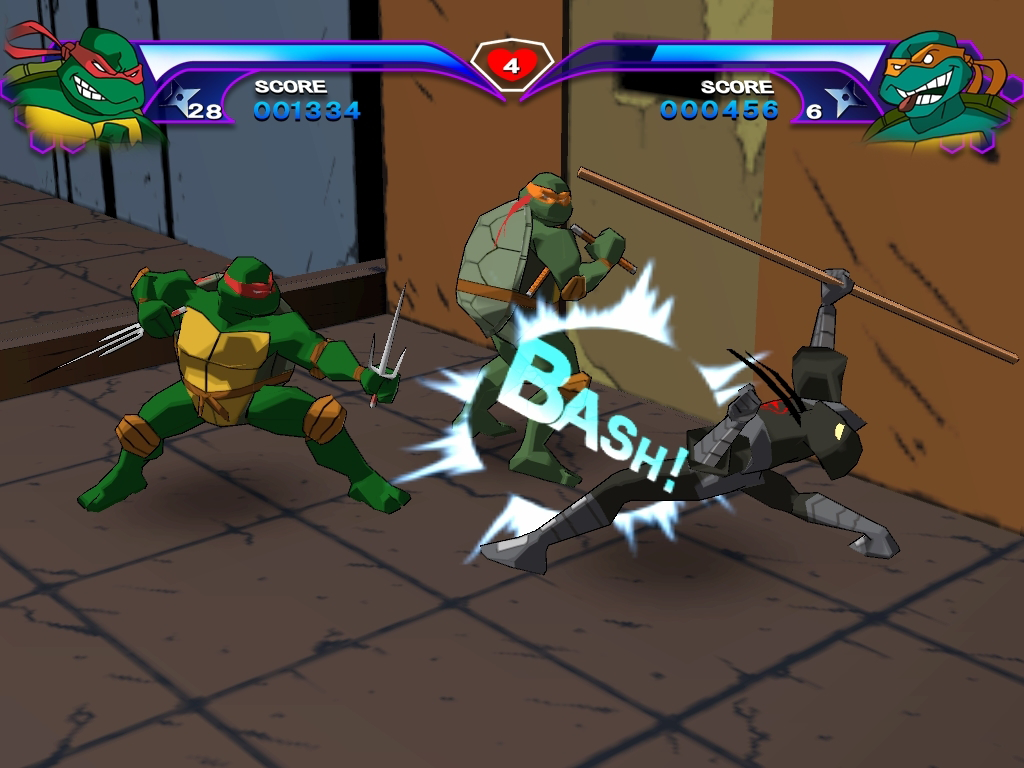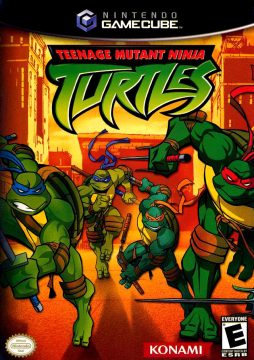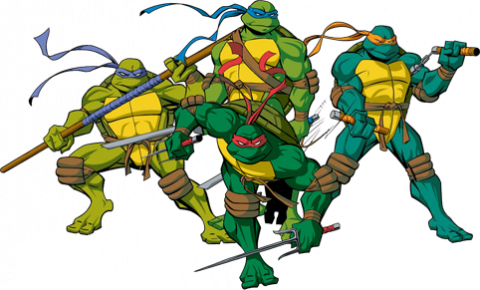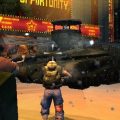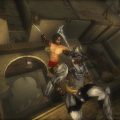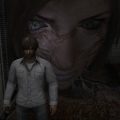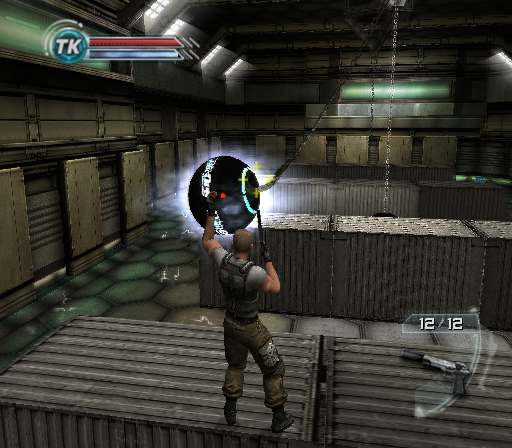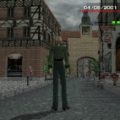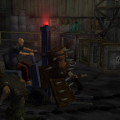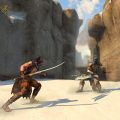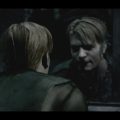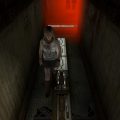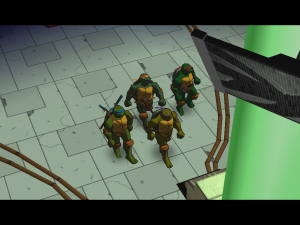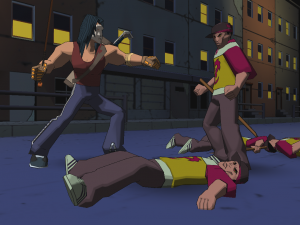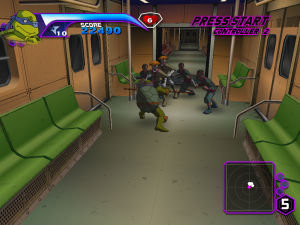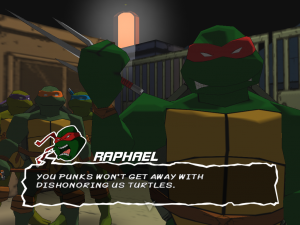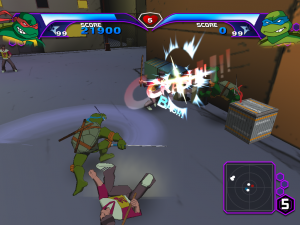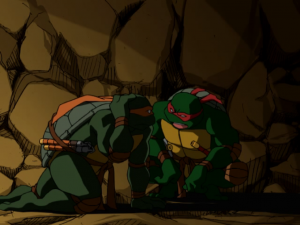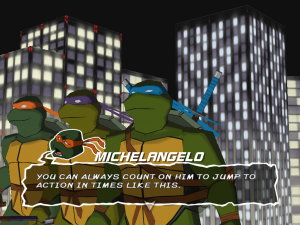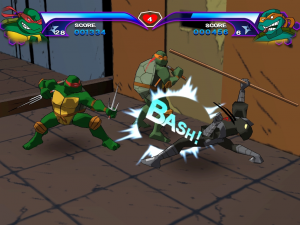- Teenage Mutant Ninja Turtles (NES)
- Teenage Mutant Ninja Turtles: The Arcade Game
- Teenage Mutant Ninja Turtles: World Tour
- Teenage Mutant Ninja Turtles: The Manhattan Missions
- Teenage Mutant Ninja Turtles III: The Manhattan Project
- Teenage Mutant Ninja Turtles: Turtles in Time
- Teenage Mutant Ninja Turtles: Hyperstone Heist
- Teenage Mutant Ninja Turtles: Fall of The Foot Clan
- Teenage Mutant Ninja Turtles II: Back From The Sewers
- Teenage Mutant Ninja Turtles III: Radical Rescue
- Teenage Mutant Ninja Turtles: Tournament Fighters (Genesis)
- Teenage Mutant Ninja Turtles: Tournament Fighters (SNES)
- Teenage Mutant Ninja Turtles: Tournament Fighters (NES)
- Teenage Mutant Ninja Turtles (Console – 2003)
- Teenage Mutant Ninja Turtles (GBA – 2003)
- Teenage Mutant Ninja Turtles 2: Battle Nexus (Consoles)
- Teenage Mutant Ninja Turtles 2: Battle Nexus (GBA)
- Teenage Mutant Ninja Turtles: Mutant Melee
- Teenage Mutant Ninja Turtles 3: Mutant Nightmare (Console)
- TMNT (2007) – Console
- TMNT (2007) – NDS and PSP
- Teenage Mutant Ninja Turtles 3: Mutant Nightmare (DS)
- TMNT (GBA)
- Teenage Mutant Ninja Turtles: Smash-Up
- Teenage Mutant Ninja Turtles: Arcade Attack
- Teenage Mutant Ninja Turtle (Plug and Play)
- Teenage Mutant Ninja Turtles Fast Forward: Ninja Training NYC / TMNT: Power of 4
- TMNT: Ninja Adventures – Mini-Game and Activity Centre
- Teenage Mutant Ninja Turtles: The Ninja Tribunal / The Shredder Reborn
- Teenage Mutant Ninja Turtles: Double Damage
Bury My Shell At Damaged Property: Fall and Revival of the TMNT
By 1994, the mainstream circus around TMNT was gone. There were many reasons for the fall in popularity was both from the market changing and from poor handling. Since 1991, the ship had started steering unevenly. First of was the influx of an alarming number of anthropomorphic heroes in both comic books and television. Biker Mice from Mars, Street Sharks, Stone Protectors, all had come from the phenomena that TMNT had become. Mirage fans were upset in the massive setback in tone in the commercial product, and interest waning due to the lack of stability and creativity in the original comics which had now been dubbed Volume 2. The mainstream audience fought with similar issues, a cartoon show that began to show its paper thin concept as it progressed and a radical departure in the form of the Adventures comic book. Worst of all was the disastrous third live action movie released in 1993, which more or less sealed the coffin shut for TMNT. Kids had grown up over the last six years, but the TMNT had not grown with them. Tournament Fighters marked something of a last hurrah for the spotlight the four ninja brothers had enjoyed, ending the series’ run on a high note, unfortunately not heard by most. A Game Boy version of Tournament Fighters was rumored to be planned in some magazines, though no proof has even come to light.
The franchise did not sit still by any means, and desperately tried to regain some footing with the younger audience in a number of ways, and at the same time also focusing on the adult audience and their appetite for the return of the darker nature of the TMNT.
With the cancellation of Volume 2, Eastman and Laird handed the series over to Savage Dragon author and creator Erik Larsen at his studio Image Comics, which at the time was one of the most popular comic book publishers with Spawn, Savage Dragon and Witchblade being among the titles they published. The comic book became known as Volume 3, and under Erik Larsen and Gary Carlson heads into a much more sinister, gritty and involved world than before, never shying away from bloodshed or gruesome consequences. It seemed to be exactly what the property needed to rejuvenate interest, but fans were divided on the approach. Volume 3 was not a stranger to including mutilation, cerebral murder and even romance which before was only done in careful doses. Some celebrated this as the return of the TMNT and them finally showing the ability to grow and learn as time went by, but the comic book’s demographic also included many teens who had grown up only knowing the friendly cartoon, and the jump proved all too much for them to swallow. As a result, the comic ended on a cliffhanger on the 23rd issue, never to be resolved officially. In recent years, more and more have come to enjoy Volume 3 and expressing interest in seeing the timeline continued. Peter Laird himself removed Volume 3 from the official comic book canon due to him not being involved with it.
In 1997, TMNT would see changes that would be universally reviled. Saban, who had brought the Sentai and Metal hero series concept over to the West with Mighty Morphin’ Power Rangers, bought the rights to produce a new live action series. One of the very first pieces of information that would come out about this production, called Ninja Turtles: Next Mutation was the fact that there now would be a 5th female turtle, Venus de Milo. The idea of a female turtle had existed throughout every version of TMNT in existence, but was never approved by Peter Laird. Venus would be the perfect showcase of why the idea should never have been materialized. The series also confused viewers with its premise, sometimes claiming it was a direct continuation of the cartoon which had ended its run in 1996, other times the live action films, and lacking many characters from either, such as April. The show lasted only one season, and was quickly forgotten, and Venus banned from appearing in any future related TMNT merchandising. Next Mutation did manage to produce a first time crossover between the Power Rangers and the TMNT in the episode “Shell Shocked” in Power Rangers in Space aired in 1998.
At one point in time, Playmates Interactive Entertainment announced plans of releasing what was set to be the very first TMNT game in 3D on the PlayStation. The early stages of development were reported throughout several issues of the PSM magazine in late ’97 and early ’98 eventually reporting that the game had gone from the name TMNT 3D to Ninja Turtles: Next Mutation, presumably to be based on the TV show. After numerous delays and missing its promised street date of third quarter 1998, the game was quietly cancelled due to the collapse of Playmates Interactive Entertainment. Rocker Games were reported to have picked up the license shortly thereafter, though it was since never heard of. No screenshots were ever released to the public.
For the very first time since 1987, there were no Ninja Turtles to be found on television, and so the franchise sat out on an entire generation of the video game cycle, having no appearance on either PSX, Saturn or the Nintendo 64. A number of revivals were pitched to studio networks, including a 3D CGI test pilot, but it would take five years before the general public was ready to don their toy replica bandanas once more.
In 2003, TMNT was finally picked up again, this time by Fox and 4kids. The new series allowed for a fresh start, one that would see co-creator Peter Laird much more involved to provide for story and character background. Going back to the origin stories found in the original comics, the TMNT 2k3 series took place mostly at night, in the dark alleys and sewers of New York City as they fight the organized crime syndicates plaguing the Big Apple. The wise cracking and goof balling from the 1987 cartoon was kept with a slightly toned down approach, as did the colored bandanas. Most of the cast in the 2k3 series were also kept strictly either from the Mirage comic book or originally created specifically for it, shunning away from the characters made for the 1987 show. April is now seen by Baxter Stockman’s side as an assistant, Casey Jones is featured more prominently and even Shredder himself is not all what he seems at first sight. The new show came closest to capturing both the mature and youthful sides of the TMNT so far and was met with approval by many longtime fans, though many who had only grown up with the 1987 cartoon were not as convinced.

Not long after the debut of the show, the official video game was released onto store shelves. The new shows production team was eager to capture a lot of the magic of what made TMNT so alluring in the early 90s and rolled out the merchandising machines quickly, partnering up with most of the affiliates TMNT was associated with back in the glory days. Playmates produced a new set of action figures and playsets of high quality, and Konami were once again put to task of creating a brawler of turtle dimensions.
TMNT 2k3 plays through the first season of the TV show in a extremely condensed version, and mixes it in with all new chapters not found in the series, acting as lost episodes, similar to what the Futurama video game did only one month prior to TMNT 2k3’s release. Each level is accompanied with fully animated cutscenes taken straight from the show, though the new levels holds new animated scenes created exclusively for this game, and animated by an unspecified Japanese group. During the stages themselves, cutscenes are rendered with the in game engine, with the voice cast from the TV series reprising their respective roles. The TMNT 2k3 show did not see any of the voice actors from 1987 return.
Based heavily on the arcade brawlers of the past, the game’s layout takes the Turtles on linear paths through small 3D levels, divided into acts within each section, presented as an episode. All four turtles are selectable, featuring different movesets as well as speed, range and rate that they lose health. Attacks are grouped into five different kinds – a shuriken attack, which throws a limited number of shurikens to stun an enemy, quick attack, swing attack, uppercut and regular attack. By combining the three striking attacks, a wealthy number of combos and finisher can be performed, with each turtle having their Turtles in Time special moves hidden within these combo combinations. New moves can be unlocked at Dojo stages, a training ground in the Turtle Lair where Splinter will give tasks for the chosen turtle to complete in order to be awarded the new skills. On each stage, crates and boxes can be destroyed to find numerous temporary power ups to help against the many enemies of the game, ranging from increased strength to improved speed along with the occasional healing item. There are also different kinds of shurikens to be found inside the crates, all having different qualities. Each turtle also has a rage attack, the Gembu, which damages all foes on screen.
The stages themselves in the Story Mode are built up identically to the way they were in the arcade games, though now with the added dimension, include more platforming elements as well as a bit of adventuring to find certain items scattered around. When enemies appear, the playfield is locked to a certain amount of estate forcing the player to duke it out and get rid of all enemies before being able to continue on. The combat is much more involved in its 3D transition, with enemies now going airborn and able to be juggled into combos, or throw into exploding barrels or cars to maximize damage. The number of enemies and their appearance is greatly improved, now ranging from Purple Dragon hoodlums, to Foot Soldiers and other mutated kinds. Making use of locations found in the episodes each stage is based on, the battle goes from rooftops to alleyways and research labs.
The authenticity towards the show is quite well executed, splicing in clips from the show’s episodes between stages to tell the story along with the in game dialogue which connects the liberties the game needs to take in order to work to bridge it all together. But what is more important is the two new stages made exclusively for the game. Featuring all new animated cutscenes (which are higher definition in the computer version compared to the low resolution videos taken from the show), the animation during these cutscenes are much better than the show itself, and holds more subtle details to the facial expressions and body language of the Ninja Turtles, as well as better told stories, going into more fantastique areas. Maybe not surprisingly, one of the levels pits the turtles against a mecha version of themselves on a high chase through the city, while the other stage goes into an underground world, and shows the more gruesome sides to Shredder’s organization. The reason why these new stages work so much better is due to the fact that the stages inspired by the episodes themselves exclude a lot of vital information on the intent and consequences of both parties’ actions, merely bridging the fights together and focusing specifically on that. The Japanese designed scenes are more self contained, and have a better paced beginning and end which ties up the events much more effectively story wise. Some cutscenes are also affected according to which turtle is being used.
There are also alternative play modes in addition to the Story Mode. Two Player mode can be done for co-op throughout the campaign, and Challenge Mode is a sort of Boss Rush / 1-on-1 fighter mode which becomes unlocked after all Story Mode has been beat with all four turtles. Finishing the game unlocks a number of hidden secrets, including costumes, all of which are mentioned in the in game dialogue at some point. During the game as well, a number of secrets can be found. On each stage, Makimono scrolls can be found to unlock concept arts and 3D renders in the Gallery section, ranging from line sketches to 3D renders from the pitched 3D show several years back. Each individual turtle can find their color specific Makimono’s and also branch out from the path to unlock new characters and areas for the Challenge mode.
For the graphics, the cel-shading technique is employed to incredible results. Every corner and every particle to the game looks near identical to the cartoon show, with the characters blending in perfectly into their environments, which at times with a good positioned camera could almost fool the eye that it is a cartoon. Another high mark is the fact that the game runs on a constant 60fps, with incredibly smooth animations which can go on for quite some time with properly laid out combos, and each turtle behave and move very differently from each other. The only drawback is the actual faces of the four turtles, which up close look a bit crude, but mostly when seen from a far look acceptable. It doesn’t fare as well in the audio department however. The soundtrack is entirely forgettable, and consists of rather faint technobeats based around the new theme song, which itself is not anywhere near as memorable as the old theme song from 1987, nor as easily arranged. All characters are voiced by their cartoon show voice over artists, and the lines are well performed, but the way they loop and repeat drives a man so insane, the only logical solution is to either completely block it out or end up in a fetal position begging it to stop.
When released, the game was the subject of a rather bizarre mixed critical reception, ranging from average to terrible reviews, but with few being truly able to pinpoint specifically what made this game so much worse than the other games of the past or even current day comparisons. Some of the critique associated with the game rings true, the locations are a bit dull, locations sometimes drag while remaining restricted, it’s an overall easy game and the audio as mentioned is far from preferable. But most critics choose to start out each review with a variation of “I am the biggest fan of TMNT, but…” and from there, spout the glory of the arcade game, but speak ill of this. In games like Dynasty Warriors, the number of on screen enemies and intensity of the actual battles is much stronger than in Teenage Mutant Ninja Turtles, but as an evolution to the arcade brawler, it shows enough classic traits enjoyed from that era spliced with a much larger range of moves, narrative and replay value. Even though it was the first of the new 3D titles, it was clear even then that this was a transition title, which took one step from its predecessor into a new chapter, remaining recognizable for older fans while yet introducing the characters and the new setting to both familiar and unfamiliar audiences. As much as most critics proclaimed their love for the TMNT franchise, most did not grasp the entire purpose of the game. The beat-em-up genre is one which had one of the toughest transitions into 3D, leaving a lot to be desired in order to live up the the stellar 2D brawlers from the arcades.
It is by no means groundbreaking, but it’s a solid brawler, one which retains a lot of what made the classic games fun, pick up and play learning curve, non stop actions and smooth multiplayer action. The stages might drag on in some cases, and the sound falls a bit flat, but with a friend willing to play, it’s a good afternoon of easy fun, and with all the unlockables, the replay value is much stronger than in any other TMNT game before it. It leaves room for improvement, but it doesn’t tamper with the fundamentals that work.
The console versions released near simultaneously, except for the PC version which saw release one month after the consoles. There are no differences between these versions, though the PC allows for higher resolution than the other titles. None of the versions support four players. Across every version, the game will display seasonal changes if played on either Halloween or Christmas.
